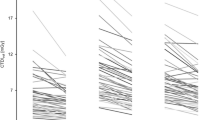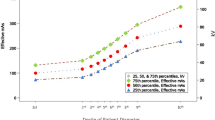Abstract
Purpose
To assess the variability of radiation dose exposure in patients affected by lymphoma undergoing repeat CT (computed tomography) examinations and to evaluate the influence of different scan parameters on the overall radiation dose.
Materials and methods
A series of 34 patients (12 men and 22 women with a median age of 34.4 years) with lymphoma, after the initial staging CT underwent repeat follow-up CT examinations. For each patient and each repeat examination, age, sex, use of AEC system (Automated Exposure Control, i.e. current modulation), scan length, kV value, number of acquired scans (i.e. number of phases), abdominal size diameter and dose length product (DLP) were recorded. The radiation dose of just one venous phase was singled out from the DLP of the entire examination. All scan data were retrieved by our PACS (Picture Archiving and Communication System) by means of a dose monitoring software.
Results
Among the variables we considered, no significant difference of radiation dose was observed among patients of different ages nor concerning tube voltage. On the contrary the dose delivered to the patients varied depending on sex, scan length and usage of AEC. No significant difference was observed depending on the behaviour of technologists, while radiologists’ choices had indirectly an impact on the radiation dose due to the different number of scans requested by each of them.
Conclusions
Our results demonstrate that patients affected by lymphoma who undergo repeat whole body CT scanning may receive unnecessary overexposure. We quantified and analyzed the most relevant variables in order to provide a useful tool to manage properly CT dose variability, estimating the amount of additional radiation dose for every single significant variable. Additional scans, incorrect scan length and incorrect usage of AEC system are the most relevant cause of patient radiation exposure.

Similar content being viewed by others
References
Brenner DJ (2004) Estimated radiation risks potentially associated with full body CT screening. Radiol 232:735–738
Lell MM, Wildberger JE, Alkadhi H, Damilakis J, Kachelriess M (2015) Evolution in computed tomography: the battle for speed and dose. Invest Radiol 50(9):629–644
Furlow B (2010) Radiation dose in computed tomography. Radiol Technol 81(5):437–450
Brenner DJ (2010) Should we be concerned about the rapid increase in CT usage? Rev Environ Health 25(1):63–68
Miglioretti DL, Johnson E, Williams A, Greenlee RT, Weinmann S, Solberg LI, Feigelson HS, Roblin D, Flynn MJ, Vanneman N, Smith-Bindman R (2013) The use of computed tomography in pediatrics and the associated radiation exposure and estimated cancer risk. JAMA Pediatr 167(8):700–707
Mathews JD, Forsythe AV, Brady Z, Butler MW, Goergen SK, Byrnes GB, Giles GG, Wallace AB, Anderson PR, Guiver TA, McGale P, Cain TM, Dowty JG, Bickerstaffe AC, Darby SC (2013) Cancer risk in 680,000 people exposed to computed tomography scans in childhood or adolescence: data linkage study of 11 million Australians. BMJ 21(346):f2360
http://www.eurosafeimaging.org. Accessed 5 Aug 2017
http://www.imagegently.org. Accessed 5 Aug 2017
Council Directive 59/2013/EURATOM of 5 December 2013 laying down basic safety standards for protection against the dangers arising from exposure to ionizing radiation. Off J Eur Union L 13, Vol 57, 17 January 2014
Connors JM (2005) State of the art therapeutics: Hodgkin’s lymphoma. J Clin Oncol 23:6400–6408
Ansell SM, Armitage J (2005) Non-Hodgkin lymphoma: diagnosis and treatment. Mayo Clin Proc 80:1087–1097
Hennessy BT, Hanrahan EO, Daly PA (2004) Non-Hodgkin lymphoma: an update. Lancet Oncol 5:341–353
Lee AI, Zuckerman D, Van den Abbeelle A et al (2010) Surveillance imaging of Hodgkin lymphoma patients in first remission. A clinical and economical analysis. Cancer 116:3835–3842
Lynch RC, Zelenetz AD, Armitage JO et al (2014) Surveillance imaging for lymphoma: pros and cons. ASCO Educ Book p e388–e395
Paolicchi F, Faggioni L, Bastiani L, Molinaro S, Caramella D, Bartolozzi C (2013) Real practice radiation dose and dosimetric impact of radiological staff training in body CT examinations. Insights Imagin 4(2):239–244
Paolicchi F, Faggioni L, Bastiani L, Molinaro S, Caramella D, Bartolozzi C (2014) Optimizing the balance between radiation dose and image quality in pediatric head CT: findings before and after intensive radiological staff training. AJR 202:1–7
Portelli JL, McNulty JP, Bezzina P, Rainford L (2016) Paediatric imaging radiation dose awareness and use of referral guidelines amongst radiology practitioners and radiographers. Insights Imaging 7(1):145–153
Paolicchi F, Miniati F, Bastiani L, Faggioni L, Ciaramella A, Creonti I, Sottocornola C, Dionisi C, Caramella D (2016) Assessment of radiation protection awareness and knowledge about radiological examination doses among Italian radiographers. Insights Imagin 7(2):233–242
Chien SH, Liu CJ, Hu YW, Hong YC, Teng CJ, Yeh CM, Chiou TJ, Gau JP, Tzeng CH (2015) Frequency of surveillance computed tomography in non- Hodgkin lymphoma and the risk of secondary primary malignancies: a nationwide population-based study. Int J Cancer 137:658–665
Zuur AF, Hilbe JM, Leno EN (2013) Beginner’s guide to GLM and GLMM with R. Highland Statistics, Newburgh
Jewell NP (2003) Statistics for epidemiology, 1st edn. Chapman and Hall, BocaRaton
R Core Team (2013) R: a language and environment for statistical computing. R foundation for statistical computing. http://www.R-project.org/. Accessed 20 July 2017
Bates D, Maechler M, Bolker B, Walker S (2014) lme4: linear mixed-effects models using Eigen and S4. R packageversion 1.1-7. http://CRAN.R-project.org/package=lme4. Accessed 20 July 2017
Angelo Canty and Brian Ripley (2016) Boot: bootstrap R (S-Plus) functions. R package version 1.3-18
Beyan C, Kaptan K, Ifran A, Öcal R, Ulutin C, Öztürk B (2007) The effect of radiologic imaging studies on the risk of secondary malignancy development in patients with Hodgkin lymphoma. Clin Lymphoma Myeloma 20(7):467–469
Lynch RC, Zelenetz AD, Armitage JO, Carson KR (2014) Surveillance imaging for lymphoma: pros and cons. Am Soc Clin Oncol Educ Book e388–e395. doi:10.14694/EdBook_AM.2014.34.e388
Ng AK, van Leeuwen FE (2016) Hodgkin lymphoma: late effects of treatment and guidelines for surveillance. Semin Hematol 53(3):209–215
Raman SP, Johnson PT, Deshmukh S, Mahesh M, Grant KL, Fishman EK (2013) CT dose reduction applications: available tools on the latest generation of CT scanners. J Am Coll Radiol 10(1):37–41
McCollough CH, Primak AN, Braun N, Kofler J, Yu L, Christner J (2009) Strategies for reducing radiation dose in CT. Radiol Clin North Am 47(1):27–40
Miglioretti DL, Johnson E, Williams A, Greenlee RT, Weinmann S, Solberg LI, Feigelson HS, Roblin D, Flynn MJ, Vanneman N, Smith-Bindman R (2013) The use of computed tomography in pediatrics and the associated radiation exposure and estimated cancer risk. JAMA Pediatr 167(8):700–707
Pearce MS, Salotti JA, Little MP, McHugh K, Lee C, Kim KP, Howe NL, Ronckers CM, Rajaraman P, Sir Craft AW, Parker L, Berrington de González A (2012) Radiation exposure from CT scans in childhood and subsequent risk of leukaemia and brain tumours: a retrospective cohort study. Lancet 380(9840):499–505
Seyal AR, Arslanoglu A, Abboud SF, Sahin A, Horowitz JM, Yaghmai V (2015) CT of the abdomen with reduced tube voltage in adults: a practical approach. Radiographics 35(7):1922–1939
Dougeni E, Faulkner K, Panayiotakis G (2012) A review of patient dose and optimisation methods in adult and paediatric CT scanning. Eur J Radiol 81(4):e665–e683
Hong SI, Ahn S, Lee YS, Kim WY, Lim KS, Lee JH (2016) Contrast-induced nephropathy in patients with active cancer undergoing contrast-enhanced computed tomography. Support Care Cancer 24(3):1011–1017
Zanca F, Demeter M, Oyen R, Bosmans H (2012) Excess radiation and organ dose in chest and abdominal CT due to CT acquisition beyond expected anatomical boundaries. Eur Radiol 22(4):779–788
Kaasalainen T, Palmu K, Reijonen V, Kortesniemi M (2014) Effect of patient centering on patient dose and image noise in chest CT. Am J Roentgenol 203(1):123–130
Toth T, Ge Z, Daly MP (2007) The influence of patient centering on CT dose and image noise. Med Phys 34(7):3093–3101
Smith-Bindman R, Lipson J, Marcus R, Kim KP, Mahesh M, Gould R, Berrington de González A, Miglioretti DL (2009) Radiation dose associated with common computed tomography examinations and the associated lifetime attributable risk of cancer. Arch Intern Med 169(22):2078–2086
Author information
Authors and Affiliations
Corresponding author
Ethics declarations
Conflict of interest
The authors declare that they have no conflict of interest.
Ethical approval
This article does not contain any studies with human participants or animals performed by any of the authors.
Rights and permissions
About this article
Cite this article
Paolicchi, F., Bastiani, L., Guido, D. et al. Radiation dose exposure in patients affected by lymphoma undergoing repeat CT examinations: how to manage the radiation dose variability. Radiol med 123, 191–201 (2018). https://doi.org/10.1007/s11547-017-0826-7
Received:
Accepted:
Published:
Issue Date:
DOI: https://doi.org/10.1007/s11547-017-0826-7




